University Statistics Assignment: Data Types, Sampling, and Analysis
VerifiedAdded on 2022/08/17
|11
|1028
|30
Homework Assignment
AI Summary
This statistics assignment provides solutions to various problems covering key statistical concepts. The assignment addresses topics including experimental versus observational studies, descriptive and inferential statistics, data types (nominal, ordinal, quantitative, and qualitative), sampling methods (simple random, cluster, and stratified), and data representation (stem-and-leaf plots, box plots, and Pareto charts). It also includes calculations for measures of central tendency (mean, median, mode), dispersion (standard deviation, variance, range), and application of Chebyshev's and Empirical rules. Furthermore, the assignment differentiates between observational studies and experimental designs and provides a bibliography of relevant statistical resources. This assignment is contributed by a student to be published on the website Desklib. Desklib is a platform which provides all the necessary AI based study tools for students.
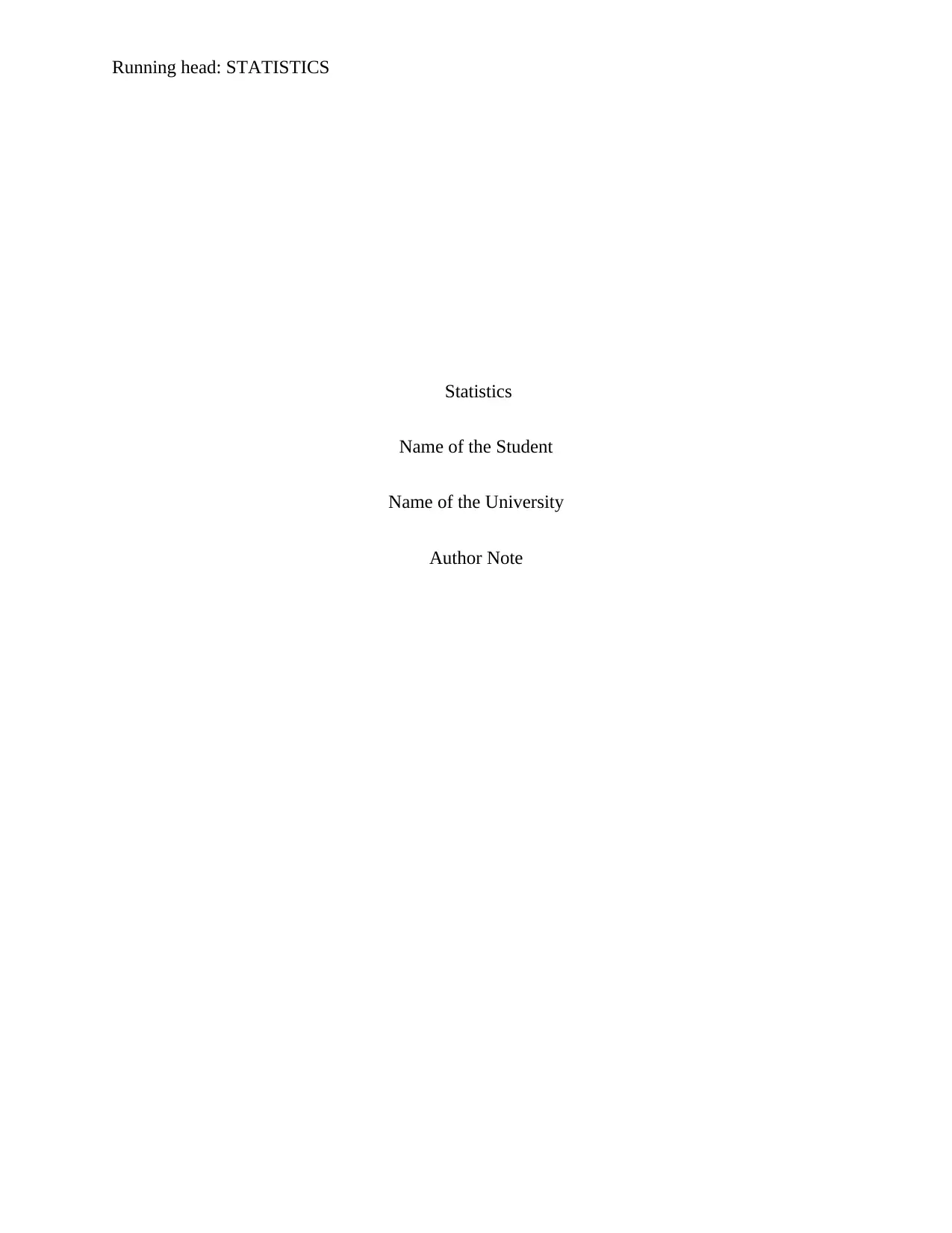
Running head: STATISTICS
Statistics
Name of the Student
Name of the University
Author Note
Statistics
Name of the Student
Name of the University
Author Note
Paraphrase This Document
Need a fresh take? Get an instant paraphrase of this document with our AI Paraphraser
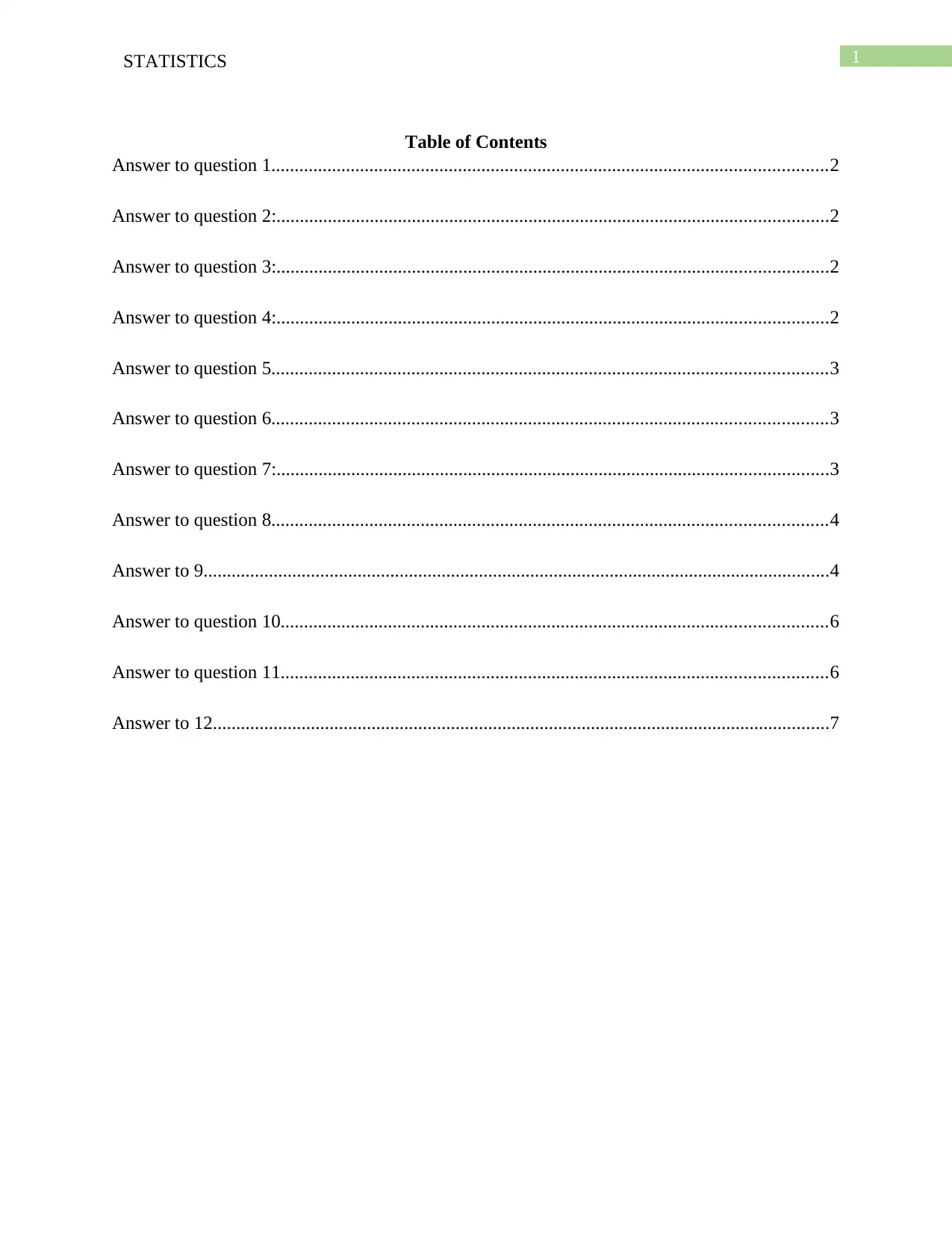
1STATISTICS
Table of Contents
Answer to question 1.......................................................................................................................2
Answer to question 2:......................................................................................................................2
Answer to question 3:......................................................................................................................2
Answer to question 4:......................................................................................................................2
Answer to question 5.......................................................................................................................3
Answer to question 6.......................................................................................................................3
Answer to question 7:......................................................................................................................3
Answer to question 8.......................................................................................................................4
Answer to 9......................................................................................................................................4
Answer to question 10.....................................................................................................................6
Answer to question 11.....................................................................................................................6
Answer to 12....................................................................................................................................7
Table of Contents
Answer to question 1.......................................................................................................................2
Answer to question 2:......................................................................................................................2
Answer to question 3:......................................................................................................................2
Answer to question 4:......................................................................................................................2
Answer to question 5.......................................................................................................................3
Answer to question 6.......................................................................................................................3
Answer to question 7:......................................................................................................................3
Answer to question 8.......................................................................................................................4
Answer to 9......................................................................................................................................4
Answer to question 10.....................................................................................................................6
Answer to question 11.....................................................................................................................6
Answer to 12....................................................................................................................................7
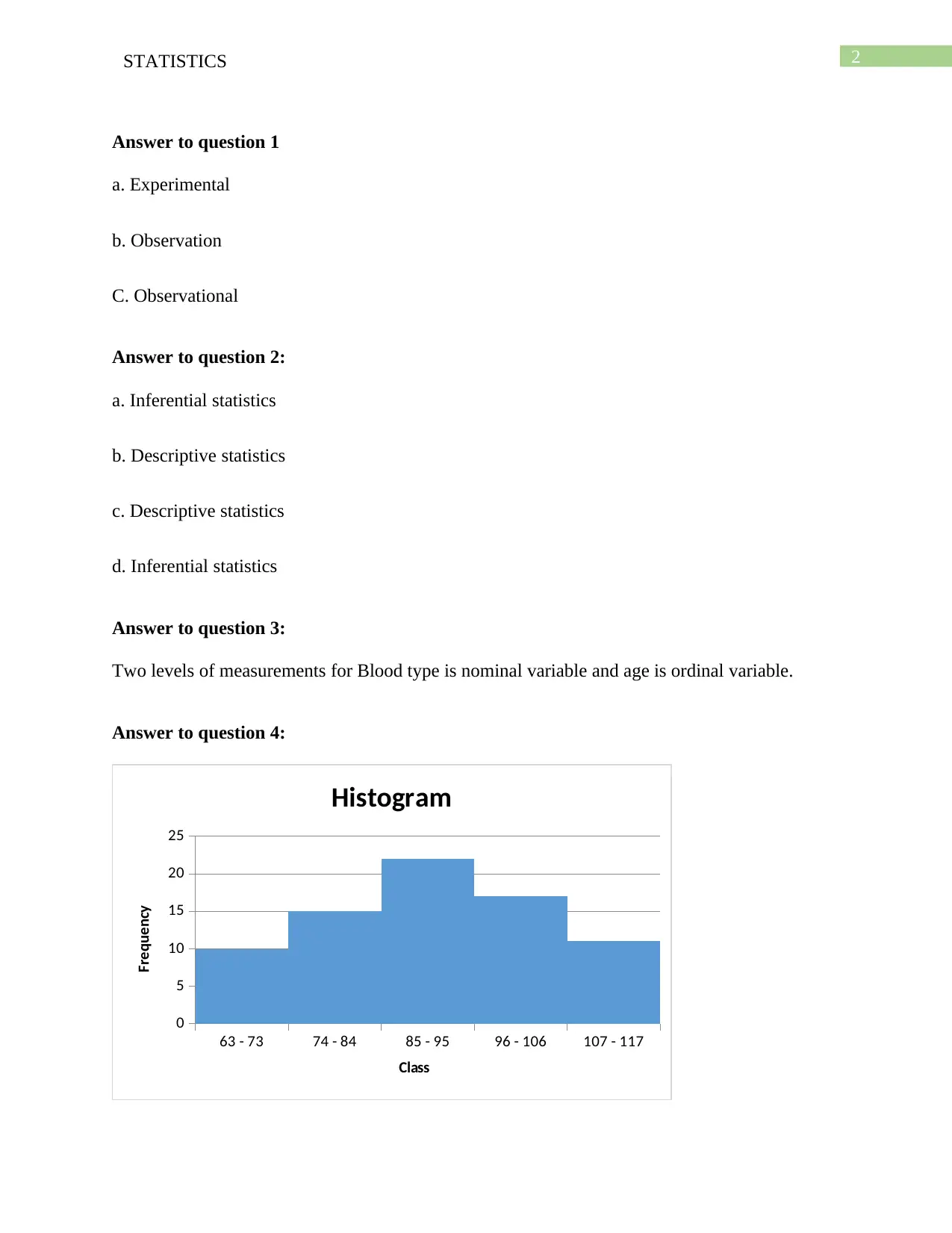
2STATISTICS
Answer to question 1
a. Experimental
b. Observation
C. Observational
Answer to question 2:
a. Inferential statistics
b. Descriptive statistics
c. Descriptive statistics
d. Inferential statistics
Answer to question 3:
Two levels of measurements for Blood type is nominal variable and age is ordinal variable.
Answer to question 4:
63 - 73 74 - 84 85 - 95 96 - 106 107 - 117
0
5
10
15
20
25
Histogram
Class
Frequency
Answer to question 1
a. Experimental
b. Observation
C. Observational
Answer to question 2:
a. Inferential statistics
b. Descriptive statistics
c. Descriptive statistics
d. Inferential statistics
Answer to question 3:
Two levels of measurements for Blood type is nominal variable and age is ordinal variable.
Answer to question 4:
63 - 73 74 - 84 85 - 95 96 - 106 107 - 117
0
5
10
15
20
25
Histogram
Class
Frequency
⊘ This is a preview!⊘
Do you want full access?
Subscribe today to unlock all pages.

Trusted by 1+ million students worldwide
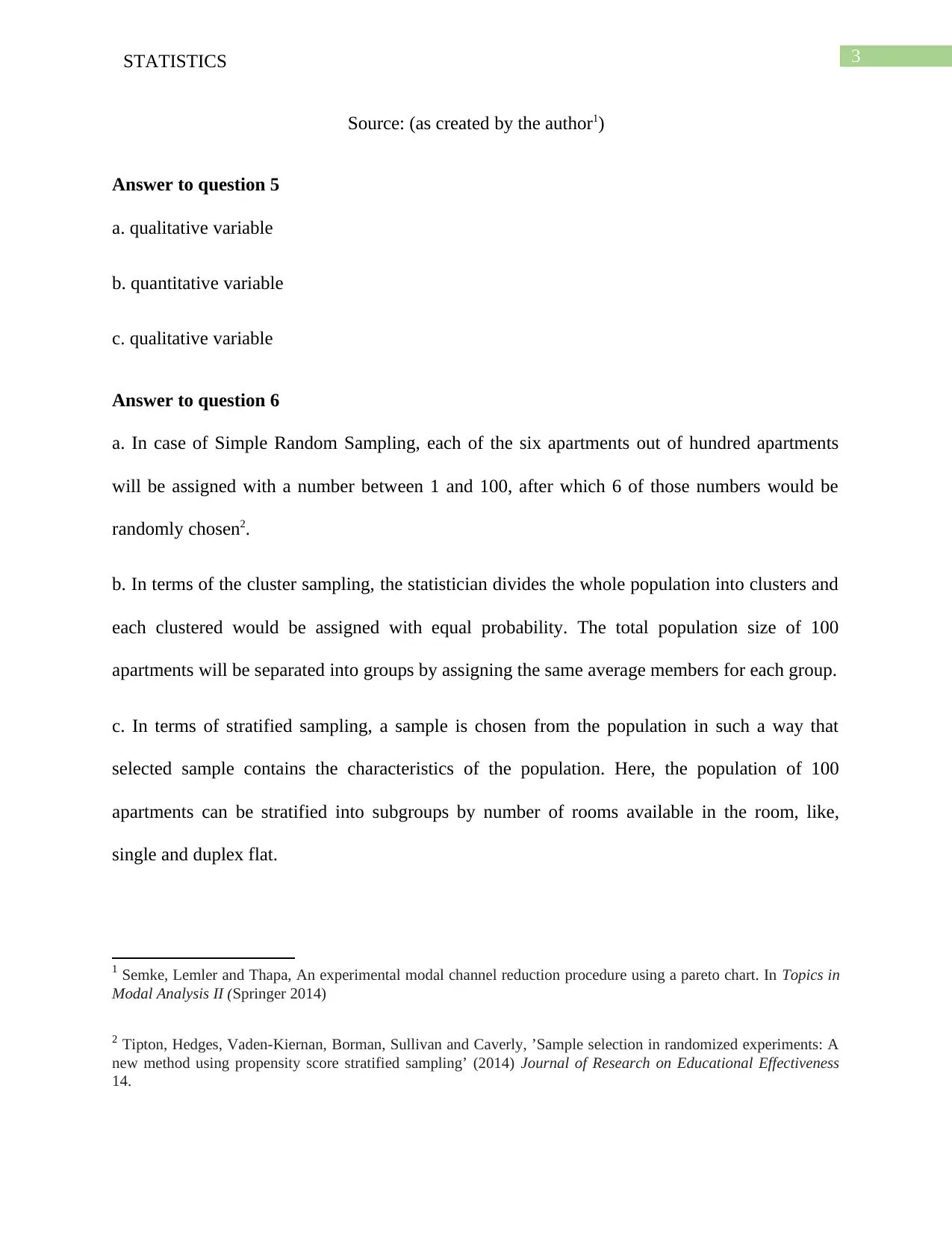
3STATISTICS
Source: (as created by the author1)
Answer to question 5
a. qualitative variable
b. quantitative variable
c. qualitative variable
Answer to question 6
a. In case of Simple Random Sampling, each of the six apartments out of hundred apartments
will be assigned with a number between 1 and 100, after which 6 of those numbers would be
randomly chosen2.
b. In terms of the cluster sampling, the statistician divides the whole population into clusters and
each clustered would be assigned with equal probability. The total population size of 100
apartments will be separated into groups by assigning the same average members for each group.
c. In terms of stratified sampling, a sample is chosen from the population in such a way that
selected sample contains the characteristics of the population. Here, the population of 100
apartments can be stratified into subgroups by number of rooms available in the room, like,
single and duplex flat.
1 Semke, Lemler and Thapa, An experimental modal channel reduction procedure using a pareto chart. In Topics in
Modal Analysis II (Springer 2014)
2 Tipton, Hedges, Vaden-Kiernan, Borman, Sullivan and Caverly, ’Sample selection in randomized experiments: A
new method using propensity score stratified sampling’ (2014) Journal of Research on Educational Effectiveness
14.
Source: (as created by the author1)
Answer to question 5
a. qualitative variable
b. quantitative variable
c. qualitative variable
Answer to question 6
a. In case of Simple Random Sampling, each of the six apartments out of hundred apartments
will be assigned with a number between 1 and 100, after which 6 of those numbers would be
randomly chosen2.
b. In terms of the cluster sampling, the statistician divides the whole population into clusters and
each clustered would be assigned with equal probability. The total population size of 100
apartments will be separated into groups by assigning the same average members for each group.
c. In terms of stratified sampling, a sample is chosen from the population in such a way that
selected sample contains the characteristics of the population. Here, the population of 100
apartments can be stratified into subgroups by number of rooms available in the room, like,
single and duplex flat.
1 Semke, Lemler and Thapa, An experimental modal channel reduction procedure using a pareto chart. In Topics in
Modal Analysis II (Springer 2014)
2 Tipton, Hedges, Vaden-Kiernan, Borman, Sullivan and Caverly, ’Sample selection in randomized experiments: A
new method using propensity score stratified sampling’ (2014) Journal of Research on Educational Effectiveness
14.
Paraphrase This Document
Need a fresh take? Get an instant paraphrase of this document with our AI Paraphraser
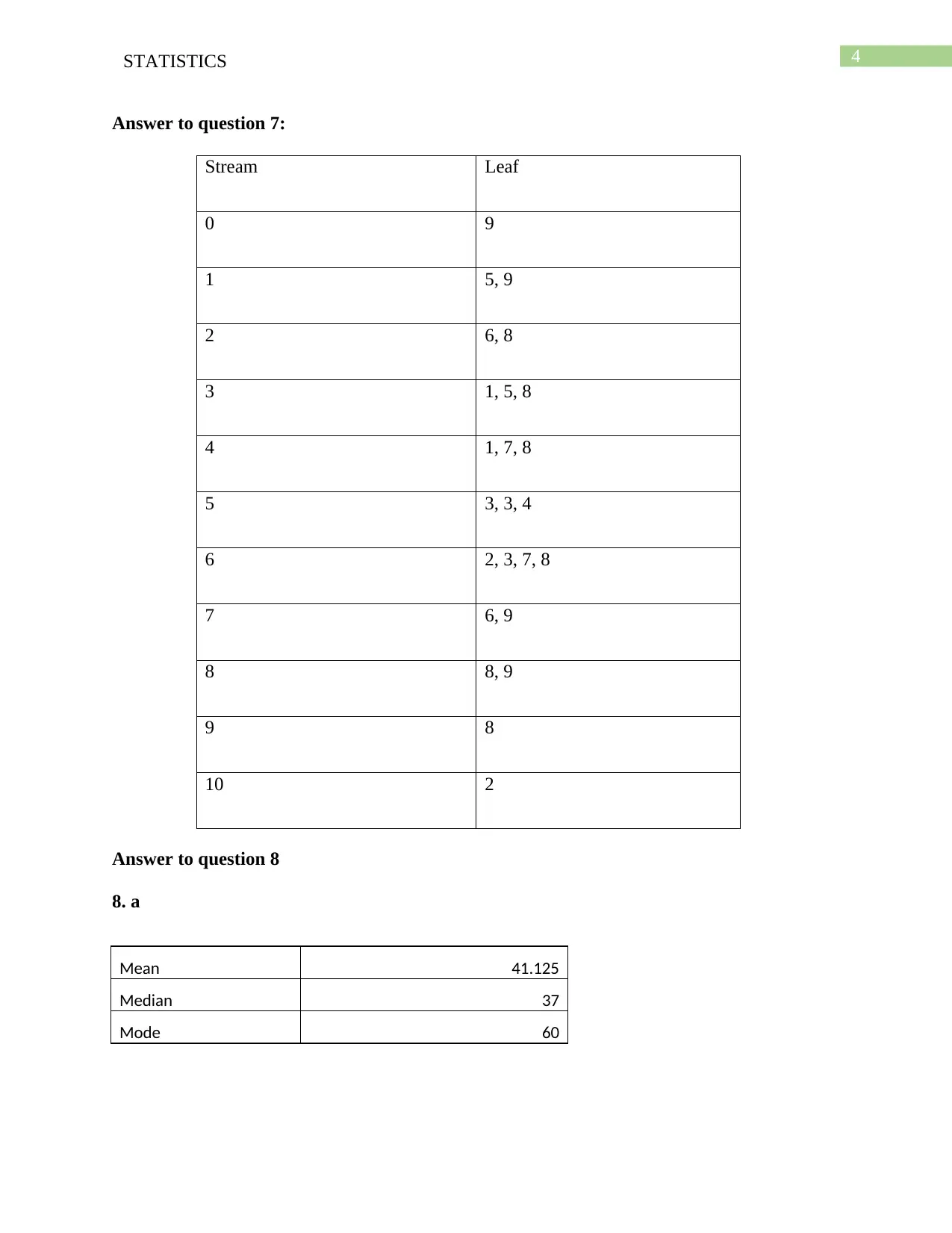
4STATISTICS
Answer to question 7:
Stream Leaf
0 9
1 5, 9
2 6, 8
3 1, 5, 8
4 1, 7, 8
5 3, 3, 4
6 2, 3, 7, 8
7 6, 9
8 8, 9
9 8
10 2
Answer to question 8
8. a
Mean 41.125
Median 37
Mode 60
Answer to question 7:
Stream Leaf
0 9
1 5, 9
2 6, 8
3 1, 5, 8
4 1, 7, 8
5 3, 3, 4
6 2, 3, 7, 8
7 6, 9
8 8, 9
9 8
10 2
Answer to question 8
8. a
Mean 41.125
Median 37
Mode 60
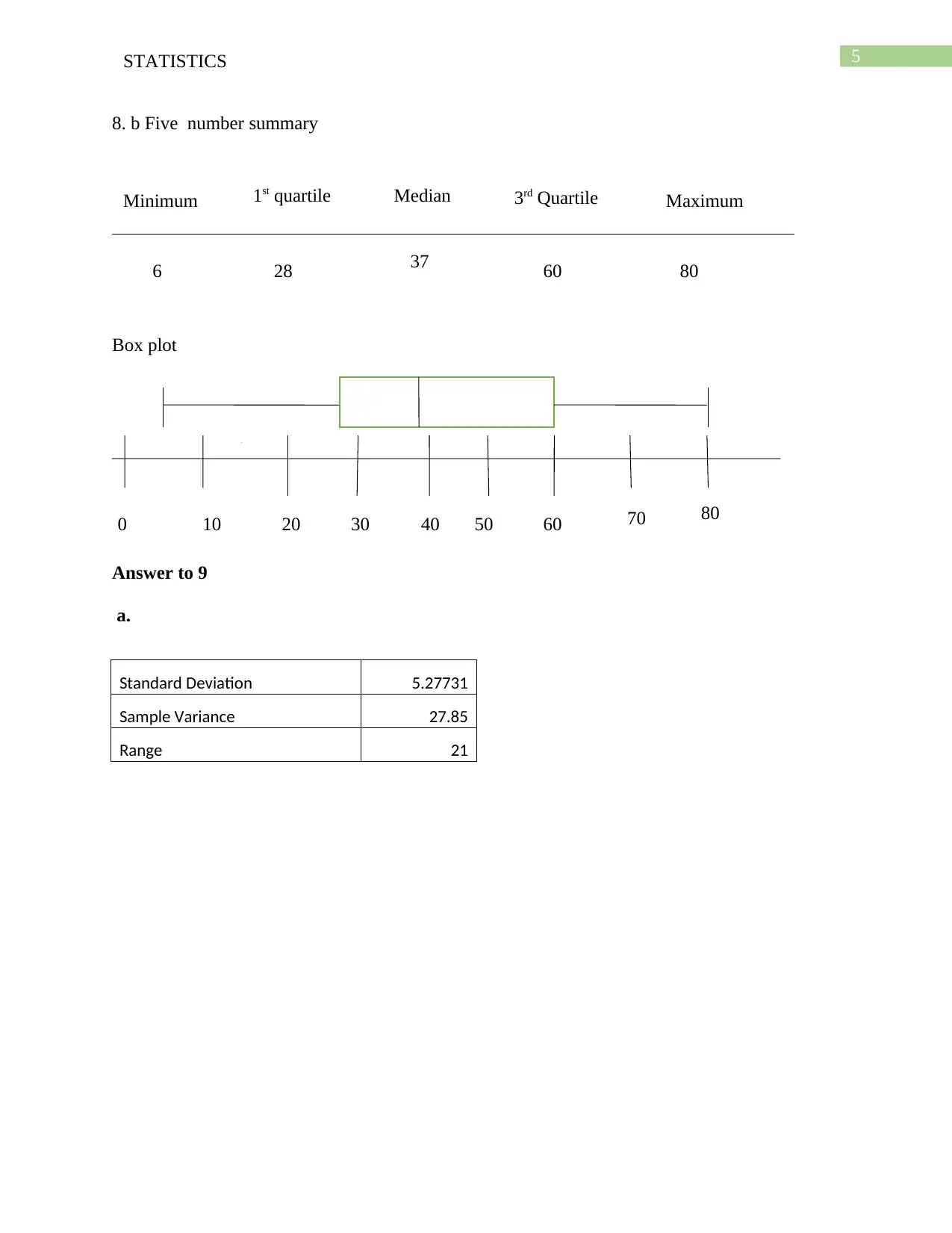
5STATISTICS
8. b Five number summary
Box plot
Answer to 9
a.
Standard Deviation 5.27731
Sample Variance 27.85
Range 21
Minimum 1st quartile Median 3rd Quartile Maximum
6 28 37 60 80
0 10 20 30 40 50 60 70 80
8. b Five number summary
Box plot
Answer to 9
a.
Standard Deviation 5.27731
Sample Variance 27.85
Range 21
Minimum 1st quartile Median 3rd Quartile Maximum
6 28 37 60 80
0 10 20 30 40 50 60 70 80
⊘ This is a preview!⊘
Do you want full access?
Subscribe today to unlock all pages.

Trusted by 1+ million students worldwide
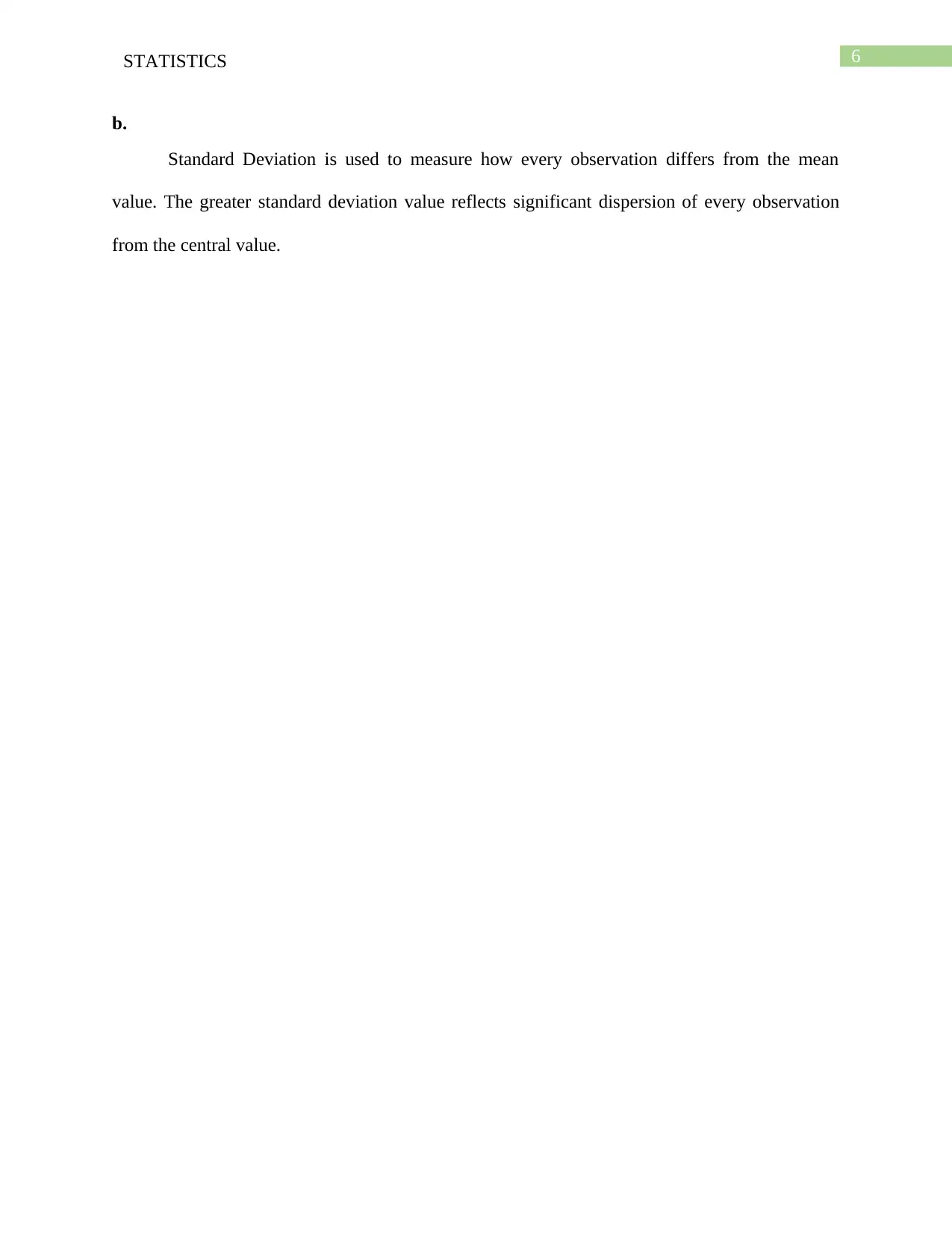
6STATISTICS
b.
Standard Deviation is used to measure how every observation differs from the mean
value. The greater standard deviation value reflects significant dispersion of every observation
from the central value.
b.
Standard Deviation is used to measure how every observation differs from the mean
value. The greater standard deviation value reflects significant dispersion of every observation
from the central value.
Paraphrase This Document
Need a fresh take? Get an instant paraphrase of this document with our AI Paraphraser
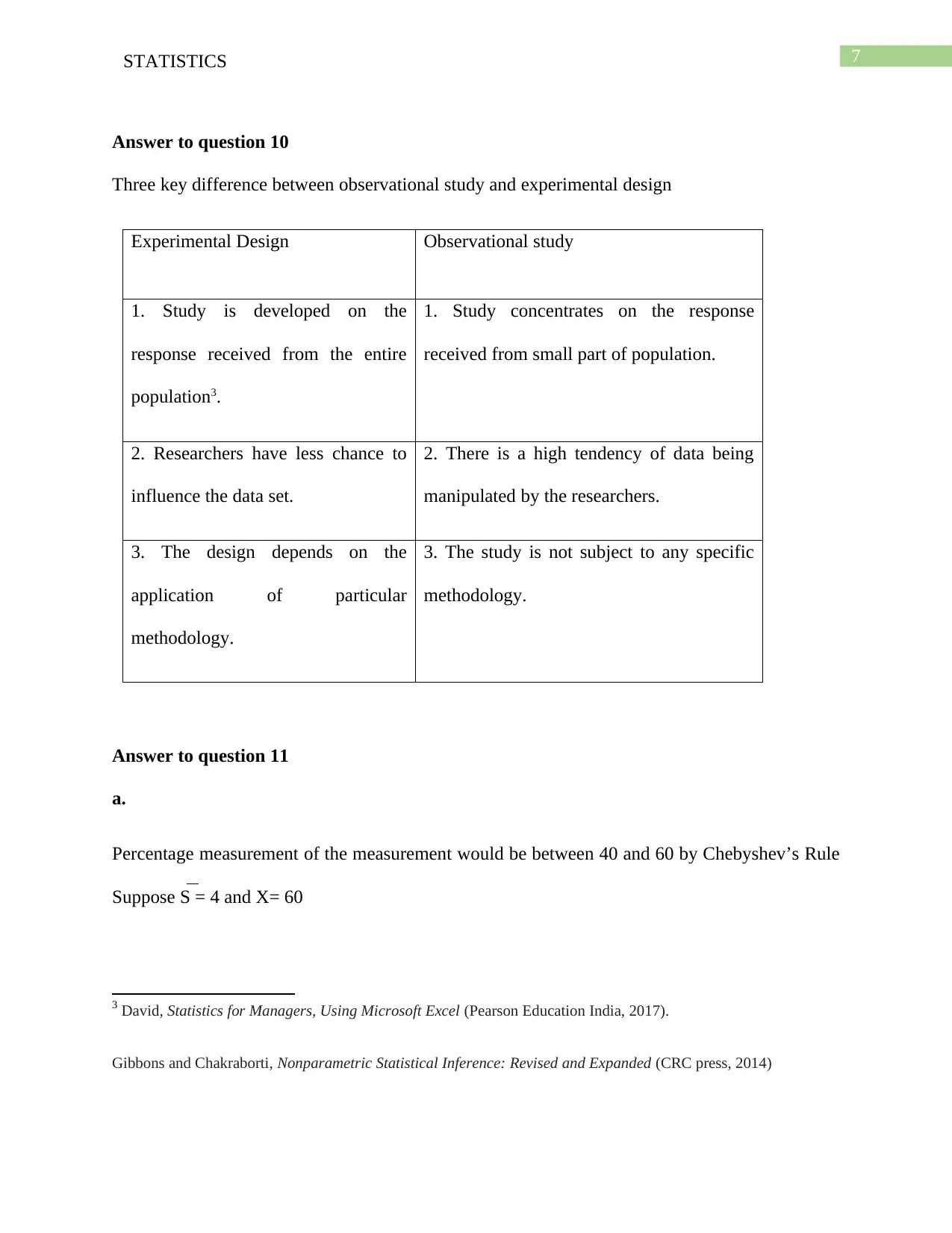
7STATISTICS
Answer to question 10
Three key difference between observational study and experimental design
Experimental Design Observational study
1. Study is developed on the
response received from the entire
population3.
1. Study concentrates on the response
received from small part of population.
2. Researchers have less chance to
influence the data set.
2. There is a high tendency of data being
manipulated by the researchers.
3. The design depends on the
application of particular
methodology.
3. The study is not subject to any specific
methodology.
Answer to question 11
a.
Percentage measurement of the measurement would be between 40 and 60 by Chebyshev’s Rule
Suppose S = 4 and X= 60
3 David, Statistics for Managers, Using Microsoft Excel (Pearson Education India, 2017).
Gibbons and Chakraborti, Nonparametric Statistical Inference: Revised and Expanded (CRC press, 2014)
Answer to question 10
Three key difference between observational study and experimental design
Experimental Design Observational study
1. Study is developed on the
response received from the entire
population3.
1. Study concentrates on the response
received from small part of population.
2. Researchers have less chance to
influence the data set.
2. There is a high tendency of data being
manipulated by the researchers.
3. The design depends on the
application of particular
methodology.
3. The study is not subject to any specific
methodology.
Answer to question 11
a.
Percentage measurement of the measurement would be between 40 and 60 by Chebyshev’s Rule
Suppose S = 4 and X= 60
3 David, Statistics for Managers, Using Microsoft Excel (Pearson Education India, 2017).
Gibbons and Chakraborti, Nonparametric Statistical Inference: Revised and Expanded (CRC press, 2014)
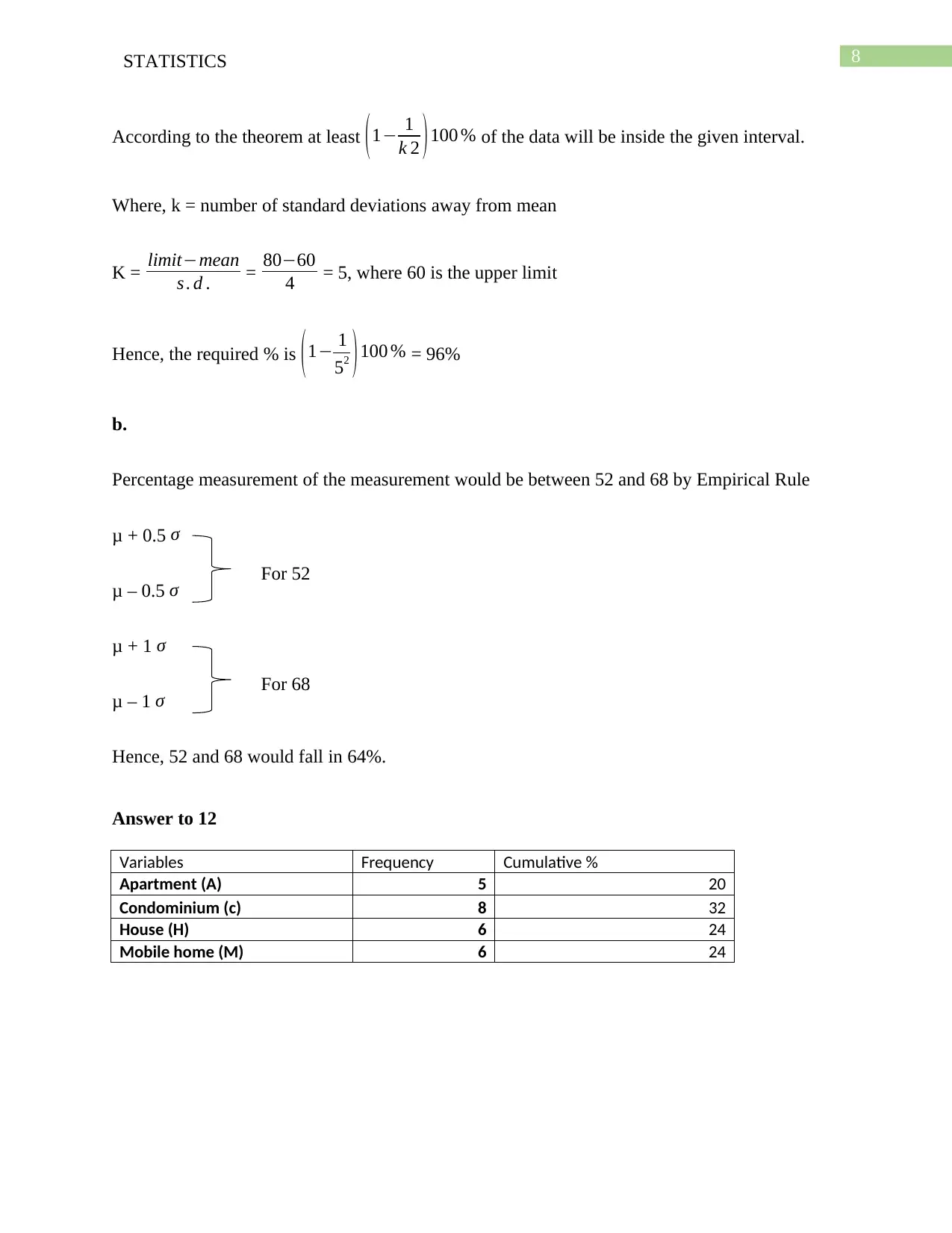
8STATISTICS
According to the theorem at least (1− 1
k 2 )100 % of the data will be inside the given interval.
Where, k = number of standard deviations away from mean
K = limit−mean
s . d . = 80−60
4 = 5, where 60 is the upper limit
Hence, the required % is (1− 1
52 )100 % = 96%
b.
Percentage measurement of the measurement would be between 52 and 68 by Empirical Rule
μ + 0.5 σ
μ – 0.5 σ
μ + 1 σ
μ – 1 σ
Hence, 52 and 68 would fall in 64%.
Answer to 12
Variables Frequency Cumulative %
Apartment (A) 5 20
Condominium (c) 8 32
House (H) 6 24
Mobile home (M) 6 24
For 52
For 68
According to the theorem at least (1− 1
k 2 )100 % of the data will be inside the given interval.
Where, k = number of standard deviations away from mean
K = limit−mean
s . d . = 80−60
4 = 5, where 60 is the upper limit
Hence, the required % is (1− 1
52 )100 % = 96%
b.
Percentage measurement of the measurement would be between 52 and 68 by Empirical Rule
μ + 0.5 σ
μ – 0.5 σ
μ + 1 σ
μ – 1 σ
Hence, 52 and 68 would fall in 64%.
Answer to 12
Variables Frequency Cumulative %
Apartment (A) 5 20
Condominium (c) 8 32
House (H) 6 24
Mobile home (M) 6 24
For 52
For 68
⊘ This is a preview!⊘
Do you want full access?
Subscribe today to unlock all pages.

Trusted by 1+ million students worldwide
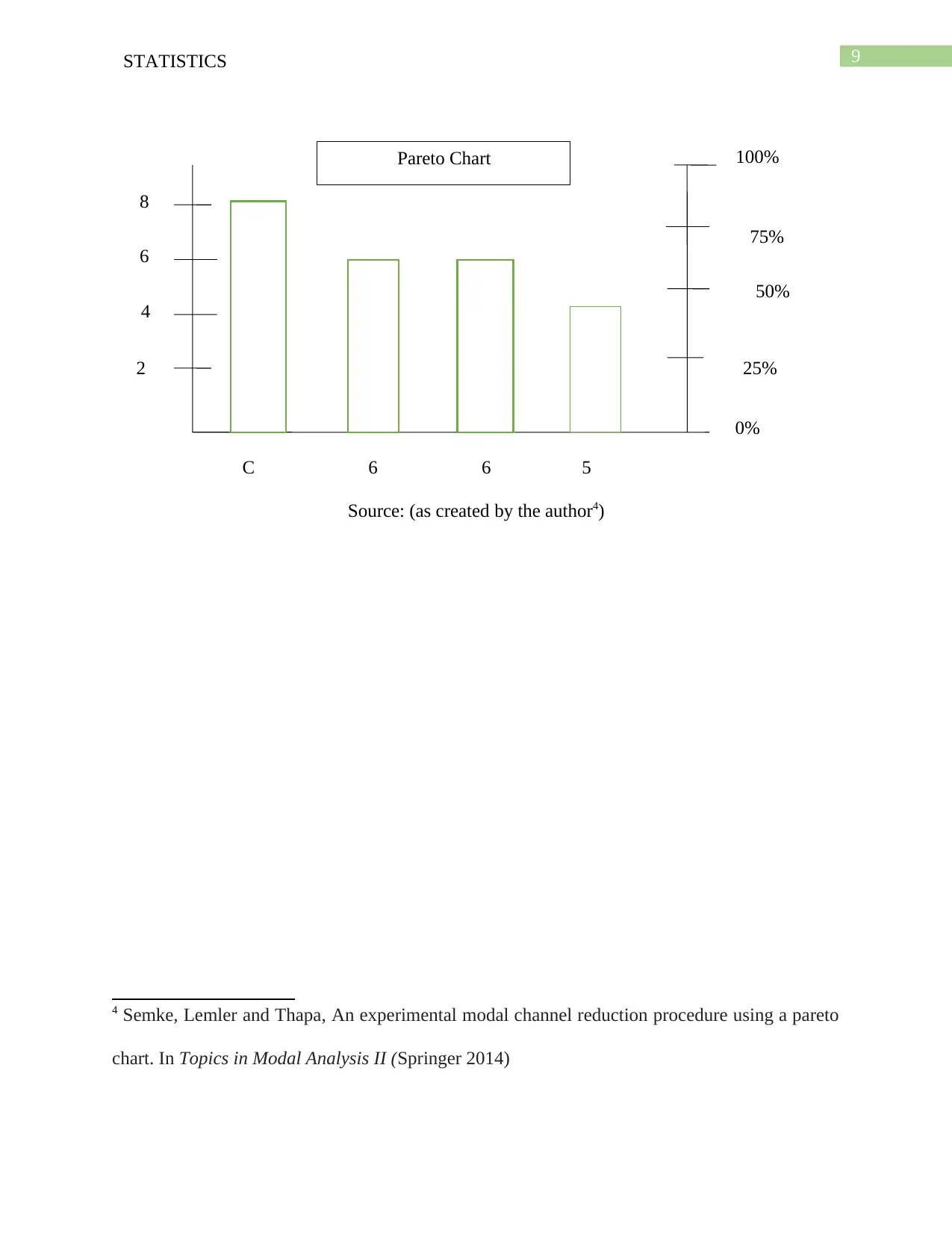
9STATISTICS
Source: (as created by the author4)
4 Semke, Lemler and Thapa, An experimental modal channel reduction procedure using a pareto
chart. In Topics in Modal Analysis II (Springer 2014)
25%
100%
75%
50%
0%
2
8
6
4
C 6 6 5
Pareto Chart
Source: (as created by the author4)
4 Semke, Lemler and Thapa, An experimental modal channel reduction procedure using a pareto
chart. In Topics in Modal Analysis II (Springer 2014)
25%
100%
75%
50%
0%
2
8
6
4
C 6 6 5
Pareto Chart
Paraphrase This Document
Need a fresh take? Get an instant paraphrase of this document with our AI Paraphraser
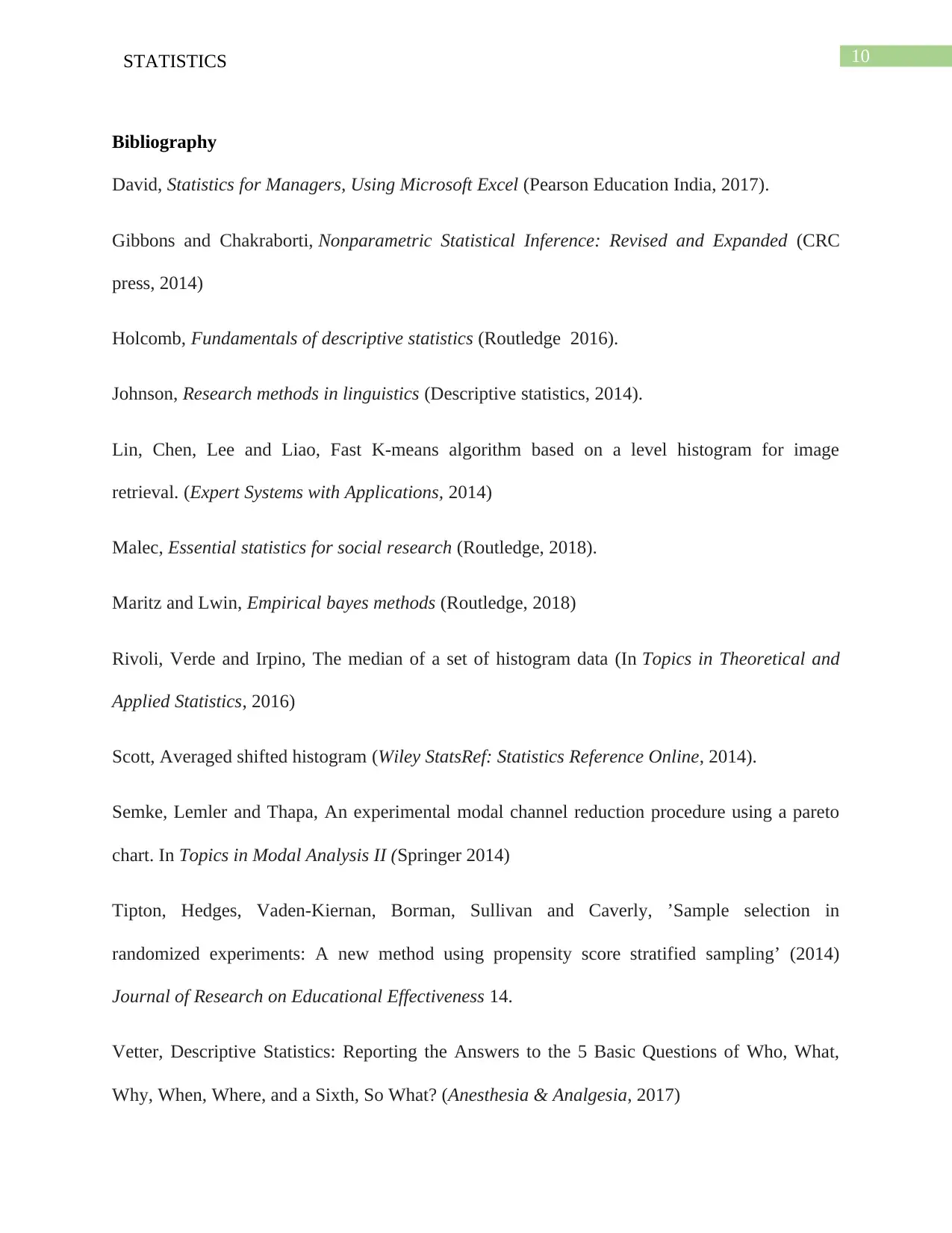
10STATISTICS
Bibliography
David, Statistics for Managers, Using Microsoft Excel (Pearson Education India, 2017).
Gibbons and Chakraborti, Nonparametric Statistical Inference: Revised and Expanded (CRC
press, 2014)
Holcomb, Fundamentals of descriptive statistics (Routledge 2016).
Johnson, Research methods in linguistics (Descriptive statistics, 2014).
Lin, Chen, Lee and Liao, Fast K-means algorithm based on a level histogram for image
retrieval. (Expert Systems with Applications, 2014)
Malec, Essential statistics for social research (Routledge, 2018).
Maritz and Lwin, Empirical bayes methods (Routledge, 2018)
Rivoli, Verde and Irpino, The median of a set of histogram data (In Topics in Theoretical and
Applied Statistics, 2016)
Scott, Averaged shifted histogram (Wiley StatsRef: Statistics Reference Online, 2014).
Semke, Lemler and Thapa, An experimental modal channel reduction procedure using a pareto
chart. In Topics in Modal Analysis II (Springer 2014)
Tipton, Hedges, Vaden-Kiernan, Borman, Sullivan and Caverly, ’Sample selection in
randomized experiments: A new method using propensity score stratified sampling’ (2014)
Journal of Research on Educational Effectiveness 14.
Vetter, Descriptive Statistics: Reporting the Answers to the 5 Basic Questions of Who, What,
Why, When, Where, and a Sixth, So What? (Anesthesia & Analgesia, 2017)
Bibliography
David, Statistics for Managers, Using Microsoft Excel (Pearson Education India, 2017).
Gibbons and Chakraborti, Nonparametric Statistical Inference: Revised and Expanded (CRC
press, 2014)
Holcomb, Fundamentals of descriptive statistics (Routledge 2016).
Johnson, Research methods in linguistics (Descriptive statistics, 2014).
Lin, Chen, Lee and Liao, Fast K-means algorithm based on a level histogram for image
retrieval. (Expert Systems with Applications, 2014)
Malec, Essential statistics for social research (Routledge, 2018).
Maritz and Lwin, Empirical bayes methods (Routledge, 2018)
Rivoli, Verde and Irpino, The median of a set of histogram data (In Topics in Theoretical and
Applied Statistics, 2016)
Scott, Averaged shifted histogram (Wiley StatsRef: Statistics Reference Online, 2014).
Semke, Lemler and Thapa, An experimental modal channel reduction procedure using a pareto
chart. In Topics in Modal Analysis II (Springer 2014)
Tipton, Hedges, Vaden-Kiernan, Borman, Sullivan and Caverly, ’Sample selection in
randomized experiments: A new method using propensity score stratified sampling’ (2014)
Journal of Research on Educational Effectiveness 14.
Vetter, Descriptive Statistics: Reporting the Answers to the 5 Basic Questions of Who, What,
Why, When, Where, and a Sixth, So What? (Anesthesia & Analgesia, 2017)
1 out of 11
Related Documents
Your All-in-One AI-Powered Toolkit for Academic Success.
+13062052269
info@desklib.com
Available 24*7 on WhatsApp / Email
![[object Object]](/_next/static/media/star-bottom.7253800d.svg)
Unlock your academic potential
Copyright © 2020–2025 A2Z Services. All Rights Reserved. Developed and managed by ZUCOL.





